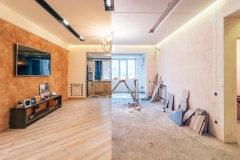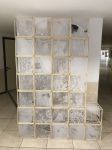
VOCATIONAL SCHOOL
Department of Interior Design (Turkish)
MICM 203 | Course Introduction and Application Information
| Course Name |
Ergonomics
|
|
Code
|
Semester
|
Theory
(hour/week) |
Application/Lab
(hour/week) |
Local Credits
|
ECTS
|
|
MICM 203
|
Fall
|
2
|
0
|
2
|
5
|
| Prerequisites |
None
|
|||||
| Course Language |
Turkish
|
|||||
| Course Type |
Required
|
|||||
| Course Level |
Short Cycle
|
|||||
| Mode of Delivery | face to face | |||||
| Teaching Methods and Techniques of the Course | Lecture / Presentation | |||||
| Course Coordinator | - | |||||
| Course Lecturer(s) | ||||||
| Assistant(s) | - | |||||
| Course Objectives | With this course, it is aimed to apply the rules of the ergonomics to the produced product, the working bench and the machines |
| Learning Outcomes |
The students who succeeded in this course;
|
| Course Description | This course includes the definition of ergonomics, importance, ergonomic elements in furniture design and production, ergonomic rules in creating interior space, relation between efficiency and ergonomics, accidents, ergonomic elements in the prevention of accidents. |
|
|
Core Courses |
X
|
| Major Area Courses | ||
| Supportive Courses | ||
| Media and Management Skills Courses | ||
| Transferable Skill Courses |
WEEKLY SUBJECTS AND RELATED PREPARATION STUDIES
| Week | Subjects | Related Preparation |
| 1 | Definition, purpose and scope of ergonomics | Sabancı, A., Sümer, SÜMER, S.K.,(2015),Ergonomi, Nobel Yayıncılık,Ankara, Chapter 1 |
| 2 | Ergonomic study of the human body | Sabancı, A., Sümer, SÜMER, S.K.,(2015),Ergonomi, Nobel Yayıncılık,Ankara, Chapter 2 |
| 3 | Anthropometric measures and measurement methods | Sabancı, A., Sümer, SÜMER, S.K.,(2015),Ergonomi, Nobel Yayıncılık,Ankara, Chapter 4 |
| 4 | Dimensions in work places | Sabancı, A., Sümer, SÜMER, S.K.,(2015),Ergonomi, Nobel Yayıncılık,Ankara, Chapter 6 |
| 5 | Operator-machine systems | Sabancı, A., Sümer, SÜMER, S.K.,(2015),Ergonomi, Nobel Yayıncılık,Ankara, Chapter 6 |
| 6 | Working environment factors | Sabancı, A., Sümer, SÜMER, S.K.,(2015),Ergonomi, Nobel Yayıncılık,Ankara, Chapter 6 |
| 7 | Noise | Sabancı, A., Sümer, SÜMER, S.K.,(2015),Ergonomi, Nobel Yayıncılık,Ankara. Chapter 9 |
| 8 | Noise | Sabancı, A., Sümer, SÜMER, S.K.,(2015),Ergonomi, Nobel Yayıncılık,Ankara, Chapter 9 |
| 9 | Midterm | |
| 10 | Lighting | Sabancı, A., Sümer, SÜMER, S.K.,(2015),Ergonomi, Nobel Yayıncılık,Ankara, Chapter 10 |
| 11 | Lighting | Sabancı, A., Sümer, SÜMER, S.K.,(2015),Ergonomi, Nobel Yayıncılık,Ankara, Chapter 10 |
| 12 | Climate of working environment | Sabancı, A., Sümer, SÜMER, S.K.,(2015),Ergonomi, Nobel Yayıncılık,Ankara, Chapter 11 |
| 13 | Chemical factors in working environment | Sabancı, A., Sümer, SÜMER, S.K.,(2015),Ergonomi, Nobel Yayıncılık,Ankara, Chapter 12 |
| 14 | Psychological factors | Sabancı, A., Sümer, SÜMER, S.K.,(2015),Ergonomi, Nobel Yayıncılık,Ankara, Chapter 13 |
| 15 | Review Of Semester | |
| 16 | Final Exam |
| Course Notes/Textbooks | Sabancı, A., Sümer, SÜMER, S.K.,(2015),Ergonomi, Nobel Yayıncılık,Ankara, ISBN: 9786055426798 |
| Suggested Readings/Materials |
EVALUATION SYSTEM
| Semester Activities | Number | Weigthing |
| Participation |
1
|
10
|
| Laboratory / Application | ||
| Field Work | ||
| Quizzes / Studio Critiques | ||
| Portfolio | ||
| Homework / Assignments | ||
| Presentation / Jury | ||
| Project | ||
| Seminar / Workshop | ||
| Oral Exams | ||
| Midterm |
1
|
40
|
| Final Exam |
1
|
50
|
| Total |
| Weighting of Semester Activities on the Final Grade |
2
|
50
|
| Weighting of End-of-Semester Activities on the Final Grade |
1
|
50
|
| Total |
ECTS / WORKLOAD TABLE
| Semester Activities | Number | Duration (Hours) | Workload |
|---|---|---|---|
| Theoretical Course Hours (Including exam week: 16 x total hours) |
16
|
2
|
32
|
| Laboratory / Application Hours (Including exam week: '.16.' x total hours) |
16
|
0
|
|
| Study Hours Out of Class |
14
|
5
|
70
|
| Field Work |
0
|
||
| Quizzes / Studio Critiques |
0
|
||
| Portfolio |
0
|
||
| Homework / Assignments |
0
|
||
| Presentation / Jury |
0
|
||
| Project |
0
|
||
| Seminar / Workshop |
0
|
||
| Oral Exam |
0
|
||
| Midterms |
1
|
20
|
20
|
| Final Exam |
1
|
28
|
28
|
| Total |
150
|
COURSE LEARNING OUTCOMES AND PROGRAM QUALIFICATIONS RELATIONSHIP
|
#
|
Program Competencies/Outcomes |
* Contribution Level
|
||||
|
1
|
2
|
3
|
4
|
5
|
||
| 1 | Will be able to have knowledge about the basic technical information of the interior design, methods and tools. |
X | ||||
| 2 | Will be able to use and interpret technical and procedural knowledge about the interior design in application and will be able to express suggestions for solutions to problems orally and in written. |
X | ||||
| 3 | Will be able to create a strategy by recognizing the market conditions and analyzing revenue management. |
|||||
| 4 | Will be able to have knowledge about legislation, fundamental values and principles in the field of interior design related to industry. |
|||||
| 5 | Will be able to think creative and innovative and apply the knowledge in an occasion different than the customary applications with an innovative way of thinking. |
X | ||||
| 6 | Will be able to take responsibility as an individual and a team member, will be able to be open-minded, constructive, confident, open to criticism and will be able to work effectively and efficiently. |
|||||
| 7 | Will be able to internalize the need to obey the values of business ethics and will be able to have and apply the social, scientific and ethical values in the stages of the collection of data, interpretation, dissemination and implementation. |
|||||
| 8 | Will be able to communicate with colleagues and follow the knowledge in the interior design field by using a foreign language. |
|||||
| 9 | Will be able to use informatics and communication technologies with computer programs in a level that required by the interior design field. |
|||||
| 10 | Will be able to adopt a lifelong learning approach, and will be able to do studies for renewing and improving their knowledge continuously. |
|||||
*1 Lowest, 2 Low, 3 Average, 4 High, 5 Highest



